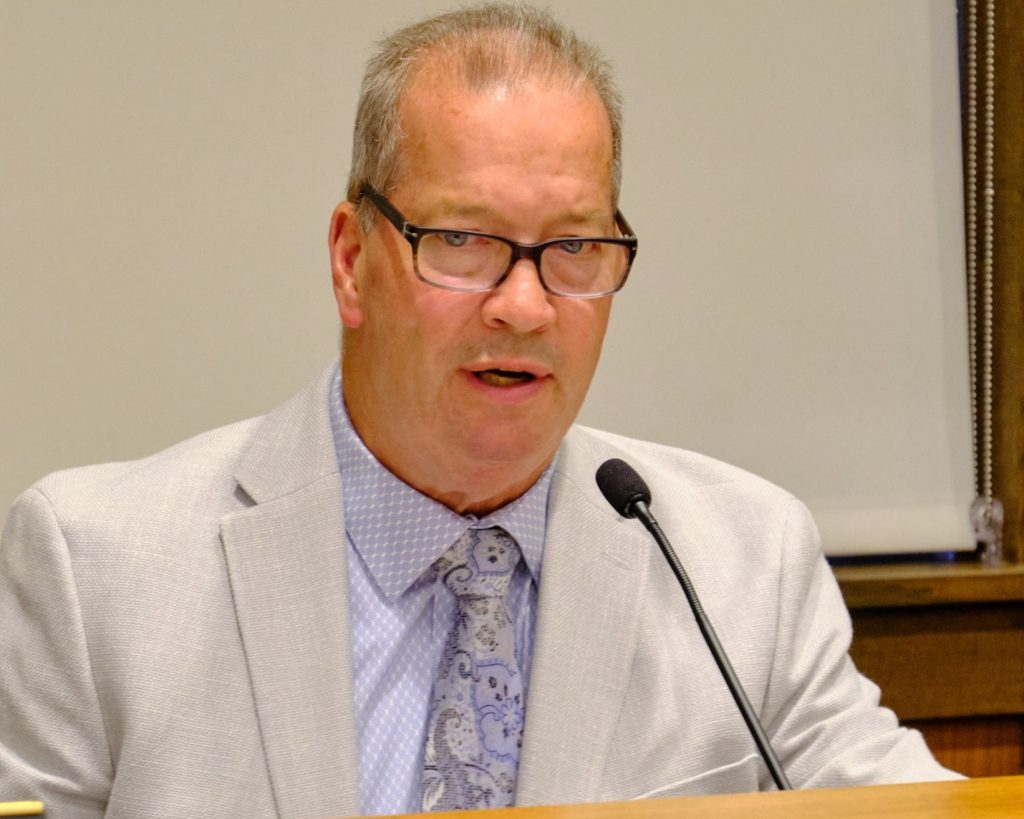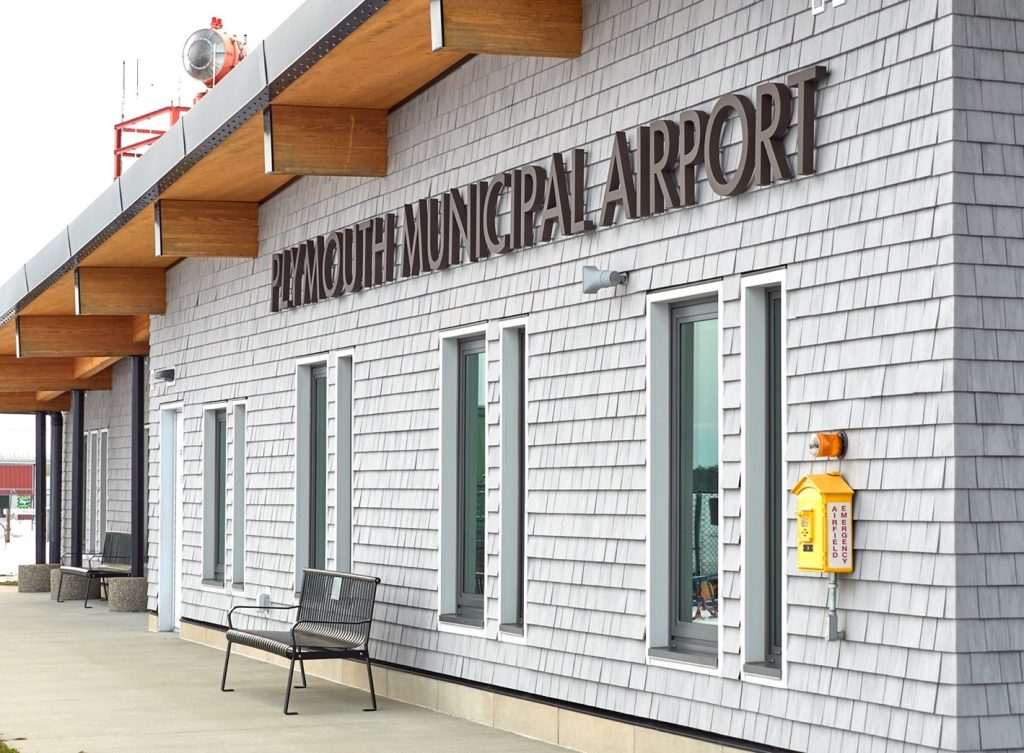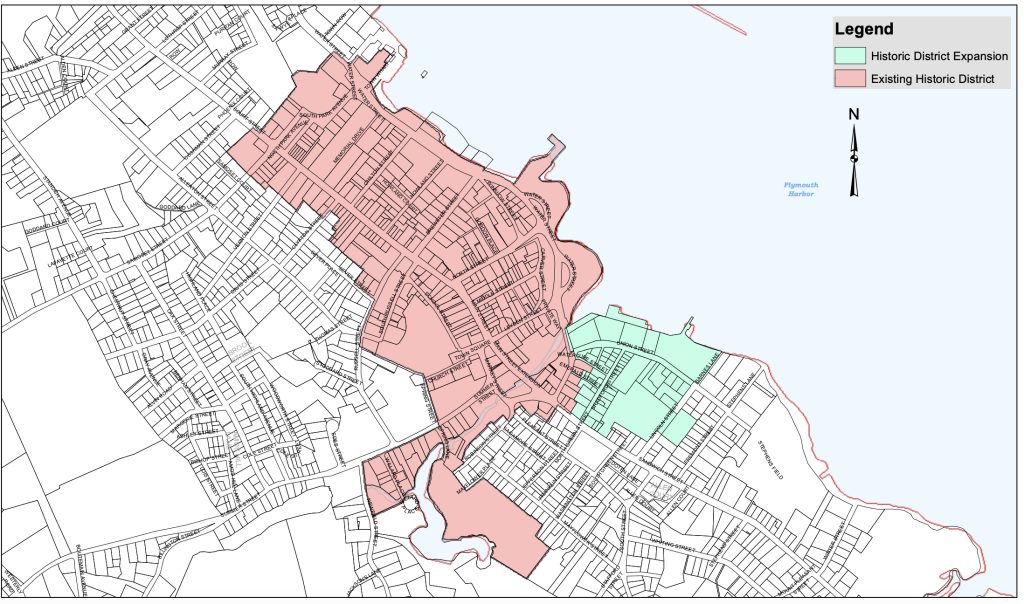Each spring, Plymouth holds a combination regular and special town meeting at which much of its business gets done. This year, it’s on April 6, at the Plymouth North High School auditorium, starting at 8 a.m. Usually, it involves a lot of coffee drinking, lively debates, and fair amount of political maneuvering.
Think of Town Meeting as Plymouth’s legislature, with 162 elected members. It’s overseen by the town moderator, Steve Triffletti, who is known for keeping the proceedings civil, and moving at a brisk pace. He only votes in the event of a tie.
Each of Plymouth’s 18 voting precincts elects nine Town Meeting members to three-year terms. Those terms are staggered so that three members from each precinct are elected at the annual town election in May.
The public can attend Town Meeting. It will also be streamed live by PACTV. Anyone can speak at the meeting – even people who are not Plymouth residents – but only after elected Town Meeting members have their say.
Financial articles on the special meeting warrant apply to the current fiscal year. Financial matters on the regular warrant apply to the next fiscal year (which starts on July 1). All other agenda items can go on either warrant. The two meetings are held consecutively, and the work is usually completed in one day.
There are 12 articles on the special meeting warrant, and 21 on the regular warrant (though one, article 20, was later withdrawn.)
Plymouth Independent reporters Michael Cohen, Andrea Estes, and Fred Thys combed through the agendas to preview some of the most newsworthy articles.
SPECIAL TOWN MEETING
Article 4: New DPW offices
Article 4 would authorize the town to buy the building at 22 Mary B Lane in the Camelot Industrial Park off Long Pond Road for use as new administrative offices for the Department of Public Works.
The building abuts existing DPW buildings at 159 and 169 Camelot Drive and would be a natural extension of that campus, town officials say. Their plan is to consolidate administrative offices from several DPW divisions into the new building, then repair and repurpose 159 and 169 Camelot Drive to create more internal storage space for DPW vehicles and equipment.
The building at 22 Mary B Lane has approximately 11,000 square feet of space on the ground floor, with potential for expansion on a second level. It sits on 1.05 acres. The property is owned by Balboni LLC and is assessed for $1,545,800.
The article seeks $3.4 million to cover the negotiated purchase price of $2.5 million plus money to pay for design and project management services for renovation of the property.
Not included in this article is funding for the estimated $9 million cost to convert 22 Mary B Lane into administrative offices. Final construction costs will be determined once the design is completed. That funding would be subject to future Town Meeting approval.
The article was proposed by the Select Board. The Advisory & Finance Committee voted unanimously to recommend its approval.
–Michael Cohen
Article 11: Cracking down on loitering

Article 11 would create an anti-loitering law. As originally written, it would have made it a violation for anyone to hang around a street, sidewalk, or parking lot “with the intent to cause public inconvenience, annoyance or alarm or recklessly create a risk of public inconvenience, annoyance or alarm.”
But after the Advisory & Finance Committee found the wording “too restrictive,” the bylaw was re-written to apply only to loitering in a parking lot between 8 p.m. and 6 a.m.
At a meeting of town meeting precinct chairs on March 21, Police Chief Dana Flynn said parking areas have become popular gathering spots, and the police have limited ways to control the crowds. “We respond to many calls and take action when we can,” he said. “We’re presenting this bylaw to assist our officers before it becomes a larger problem, and to protect our citizens.”
Select Board member Kevin Canty said there are problems in a few parking lots in North Plymouth and downtown.
“People are hanging out at night, making a ruckus, and disturbing the residents,” he said.
Flynn told the Select Board previously that police have difficulty making arrests for disturbing the peace or being disorderly because those laws require a resident to come forward as a witness, Canty said.
The proposed bylaw would make the violations civil infractions, rather than criminal offenses, punishable by fines — $50 for the first offense, $100 for a second offense and $150 for any additional offenses.
Police would have discretion to waive fines for a first violation, Canty said.
And if someone refuses to leave despite being fined, said police spokesman Jason Higgins, “they would be subject to arrest for trespassing.”
–Andrea Estes
Article 12: More liquor licenses

Article 12 would authorize the town to seek legislation allowing Plymouth to issue two new liquor store licenses, a measure that has already generated controversy among Town Meeting members.
Select Board members say there is demand for liquor stores in South Plymouth, where there are currently none. Residents must drive to Wareham or Bourne to buy alcohol, according to Select Board member Charlie Bletzer.
“We have them (liquor stores) in North Plymouth, West Plymouth, Manomet. All other parts of Plymouth have them, so why shouldn’t they?” said Bletzer, adding that he’s gotten multiple requests for the licenses.
The town has already issued its allotment of 16 full liquor store licenses, said Select Board member Kevin Canty, who is also supporting the measure.
One of the licenses would likely go to Paresh Patel, who owns the Store at Sandy Pond, which already sells beer and wine.
“We have tons of requests from customers,” said Patel, who presented Bletzer with a petition signed by 300 customers.
The second license might go to the Redbrook development, which has no retailers selling alcohol, including beer and wine.
Linda Burke, a spokeswoman for A.D. Makepeace, the developer of Redbrook, said the company did not request a liquor license, but having one available “will give us some flexibility when seeking retail tenants for the commercial buildings” planned for the development.
“We have heard from some residents that a liquor store would be a welcome addition,” she added.
Several Town Meeting precinct chairs, meeting on at the March 21 session to review Town Meeting articles, voiced opposition to the proposal.
Kathryn Holmes, who represents the area around the Sandy Pond Campground, said there are already two liquor stores within a mile of the Store at Sandy Pond. She questioned whether the Select Board members had asked other liquor store owners if they are worried about new competition.
Bletzer argued there is more than enough demand to support all the liquor stores.
Joe Hutchinson, who represents the Redbrook area, said residents are concerned about the possible location of a liquor store near a children’s playground.
He also said some residents fear a big liquor store chain might want to open there, which would be out of character with the neighborhood.
–Andrea Estes
REGULAR TOWN MEETING
Article 9: Airport runway extension

Article 9, Item A45, would authorize the Airport Commission to spend $380,000 from its enterprise fund to pay for an extension of one of Plymouth Municipal Airport’s runways and the rebuilding of some taxiways, as well as the expansion of the capacity of the airport’s sewage treatment plant. The funds represent 5 percent of the total cost of the project, with another 5 percent provided by the state, and the rest by the Federal Aviation Administration.
The project would extend runway 6-24 – the most used runway because of prevailing winds – by 351 feet to a length of 5,001 feet, or nearly a mile long. The type of jet that the airport is designed for, the Falcon 2000, needs 5,500 feet of runway for optimal conditions, meaning it can land and take off with a full payload and have room to spare for emergencies. Lengthening the runway would allow the jets to land and take off with a bigger payload than they do now. It would also allow the airport to sell more fuel for those heavier planes. The project is undergoing an environmental impact study, in part to determine whether it will affect groundwater and the Plymouth-Carver single-source aquifer.
Supporters of the project, including the Airport Commission, say it will not lead to more or bigger jets using the airport. Rather, it would increase the safety margin for planes using the airport now.
Opponents, including some people who live near the airport, worry that it will bring more and bigger jets, along with more noise. They also say that the town did not do enough to reach out to residents for input.
-Fred Thys
Article 14: Accessory Dwelling Units

Article 14 would amend the zoning bylaw to allow for Accessory Dwelling Units (ADUs) to be built in all residential and mixed-use districts “by right,” meaning no special permit or public hearing required.
Sometimes called an in-law apartment, an ADU would be limited to 900 square feet and have to meet all other building, safety, parking, and health requirements. ADUs could not be created within condominiums or attached townhouses. Mobile homes or recreational vehicles parked next to a single-family home would not qualify as an ADU. Importantly, ADUs could not be used as short-term rental units such as through Airbnb.
Advocates say ADUs are part of the solution to the affordable housing crunch in town by increasing the number of year-round rental units in neighborhood settings. Rental income from an ADU could help senior homeowners make ends meet and provide relatively affordable apartments for younger people who want to live in Plymouth but are now priced out of the market.
Opponents say that allowing ADUs by right would change the character of single-family neighborhoods, stress the town’s water supply and potentially pollute ponds from added septic system usage. They prefer to keep the current zoning bylaw in place, which requires a special permit (and a public hearing process) for anyone seeking to add a second residential unit to a property.
-Michael Cohen
Article 15: A bigger historic district

Article 15 would extend the Plymouth Historic District. The measure would expand the Downtown & Waterfront District to include Union Street out to Barnes Lane and Lincoln Street, the west side of Lincoln Street plus 11 Lincoln St. (once the high school, later Town Hall, now the Plymouth Public Schools administration building) on the east side, and Bradford Street, and would include the Plymouth Yacht Club, the Nathaniel Morton School, and the Plymouth Marina.
“What gave us the jump start to do it was the marina building,” said Michael Tubin, chair of the Historic District Commission. The Water Street façade of that building was part of a foundry built in 1867. The owners applied to demolish the building. The Commission imposed a 12-month demolition delay. Neighbors tried to save the building, to no avail. The demolition delay was lifted, and Tubin said teardown is imminent.
The expansion would add a total of 59 properties to the historic district, and it would expand the protection of Plymouth’s architectural history well beyond the Pilgrims, including structures built between 1844 and 1950. It requires a two-thirds vote of support from Town Meeting. If it passes, the Historic District Commission could prohibit demolition within the area.
Supporters argue it is a “remarkably intact” nineteenth-century neighborhood that offers a “visual reminder of hardworking Plymoutheans” who worked in shipping, fishing, and industry.
“It’s an important area to protect,” Tubin said.
Supporters also say that it is more environmentally friendly to restore old buildings than it is to demolish them and that historic districts create walkable neighborhoods and bring tourism and tax revenues.
Opponents have argued that a parking and traffic study is needed, that they don’t want the Historic District Commission to tell them what to do with their property, that sometimes demolition is necessary, that lot sizes alone will maintain the character of the neighborhood, that small property owners will be unfairly burdened, and that nothing historically significant happened in the neighborhood.
-Fred Thys
Article 16C: $4 million for affordable housing
Article 16C would appropriate $4 million from the Community Preservation Fund to the Grantham Group for the construction of 62 affordable one-bedroom apartments for people age 62 and over at Redbrook. The total cost of the project is estimated at $25 million, with another $500,000 coming from the town’s Affordable Housing Trust and the rest from private borrowing and the state.
The Community Preservation Committee voted 4-2 for the project. The Advisory and Finance Committee initially voted unanimously against it, but later reversed itself after developers rotated the building, added 10 more units of affordable housing, more parking, and a sidewalk. A.D. Makepeace Company would donate the land.
The developers have committed to making all the units affordable. Ten would be reserved for people making 80 percent or less of the average median income as determined by the U.S. Department of Housing and Urban Development. Thirty units would be for people making 60 percent or less of average median income. And 13 units would be reserved for people making 30 percent or less of average median income.
The developers say that at the town’s request they can give preference to Plymouth residents for 43 units, at least initially, provided state officials approve.
Opponents point to Makepeace’s unfulfilled commitment to build 103 units of affordable housing in Plymouth at its own expense when it was granted rezoning to build the planned community. Makepeace has only built 15 affordable housing units so far. The critics object to using Community Preservation funds to allow Redbrook to meet its prior obligation. Some residents of Redbrook say that the project is too big and too far from amenities.
-Fred Thys
Article 16A: $3 million toward a family shelter
Article 16A would appropriate $3 million from the Community Preservation Fund for a family shelter to be run by the Plymouth Area Coalition for the Homeless. The funds would go towards the $7 million cost of renovating a building at 54 Industrial Park Road. The shelter could house up to 26 families. Remaining funds would come from the state.
The Community Preservation Committee unanimously recommended funding the project, but in an acrimonious session that resulted in the resignation of two members, the Advisory and Finance Committee voted 8-6 against it.
Opponents point out that the project would not be eligible for credit towards the number of affordable housing units in Plymouth under Chapter 40B, the state law that allows developers to bypass most zoning restrictions in cities and towns that do not meet a minimum threshold of affordable housing units.
During the contentious meeting of the Advisory and Finance Committee, member Timothy Lawlor also raised fears of crime and immigration. He questioned Giovanetti about police visits to the Pilgrim’s Hope Shelter at 140 Bishop’s Highway — Route 80 — in Kingston, and about the origin of families housed at the Baymont by Windham Hotel in Kingston, many of whom are seeking asylum in the United States.
Supporters of the project point to its proximity to public transit and jobs and the availability of separate space in the building for educational programs for homeless families. Sue Giovanetti, executive director of the Coalition, explained at the time of the Advisory and Finance Committee vote that the shelter would serve families for several months at a time. Giovanetti, who is a member of the Plymouth Independent board, said the new shelter would help address the growing homelessness problem in Plymouth.
-Fred Thys
Budget matters

Several articles, starting with 7A, ask Town Meeting members to approve spending for the fiscal year starting July 1.
The town is requesting $293 million to pay for its operations, including $118 million to cover school spending. That amount will level fund the school department, with no new initiatives, according to school budget documents.
If approved as proposed, the town’s spending plan will substantially increase homeowners’ property taxes — by approximately 6.9 percent a year.
The owner of a home valued at $545,474 — the town’s average — would pay $488 more a year in taxes, according to the town’s budget documents.
The school budget request doesn’t include all the money officials say they will need this year.
Plymouth Public Schools Superintendent Christopher Campbell said he will need to come back for more money in the fall because the requested amount — $118,734,770 — isn’t sufficient to pay for raises that are expected to be negotiated this year with the school department’s unions — teachers, paraprofessionals, and others.
Town Manager Derek Brindisi said the town’s budget includes some new initiatives, including a crime analysis unit that will help the police deploy resources more efficiently.
“The addition of a crime analyst will allow us to pinpoint problem areas, look for trends, and help our supervisors deploy our officers in areas at the times they are needed,” police spokesman Jason Higgins said.
There is also a request to fund an online bill notification and payment tool for residents, and $90,000 to hire a communications coordinator to speak for all town departments.
At a March 21 meeting of town precinct chairs, Town Meeting member Kevin Lynch asked Brindisi why the town needs a full-time communications person when there are probably retired Plymouth residents with communications experience willing to volunteer.
Brindisi said he believes having a full-time person “who reports to work day in and day out… will bear fruit.”
The select board will also ask Town Meeting to set aside $500,000 to help pay for property around the Holtec’s decommissioning of the Pilgrim nuclear power plant that might come up for sale. The town’s Advisory & Finance Committee opposed the measure, citing financial pressures facing the town.
–Andrea Estes

